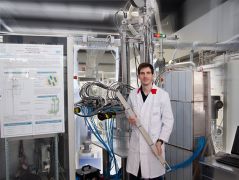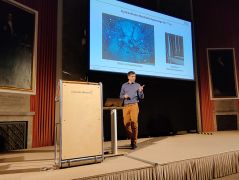MLZ is a cooperation between:
 > Technische Universität München
> Technische Universität München > Helmholtz-Zentrum Hereon
> Helmholtz-Zentrum Hereon
 > Forschungszentrum Jülich
> Forschungszentrum Jülich
MLZ is a member of:
 > LENS
> LENS > ERF-AISBL
> ERF-AISBL
MLZ on social media:

MLZ (eng)
Lichtenbergstr.1
85748 Garching
10.06.2024
Highly reactive compounds thanks to laser and plasma
Researchers at the MLZ and the Philipps University of Marburg are the first to develop a method that produces hexafluorides, which are difficult to access, in a plasma system with an additional laser heating system.

The work of Tobias Chemnitz and colleagues made it onto the cover of the renowned journal Inorganic Chemistry. © Inorganic Chemistry, Björn Koch
Hexafluorides are a group of chemical compounds consisting of six fluorine atoms and an additional central atom. Chemists can choose from 16 elements for this central atom, for which the respective hexafluoride is stable. Certain hexafluorides are used, for example, in the semiconductor industry or the switchgear of wind turbines. The researchers used ruthenium, rhodium, and platinum as the central atom elements in the current study.
Laser-based production technology
The new plasma-chemical production method is based on an improved version of an earlier system with an additional laser heating system. The laser heats the carrier material selectively to a temperature of up to 1200°C, while at the same time, the rest of the reaction chamber is kept below 100°C by a cooling system. This starkly contrasts previous methods, in which synthesis took place in special reaction chambers at high temperatures and pressures, negatively impacting the components’ service life due to the associated corrosion. The new method replaces the previously required elemental fluorine with the less aggressive nitrogen trifluoride (NF3), which only splits into free fluorine and nitrogen in the plasma source.

Dr. Tobias Chemnitz is a scientist at the MLZ and responsible for the MEDAPP instrument. © Bernhard Ludewig, FRM II / TUM
“I developed the production system as part of my doctoral thesis in Marburg. It was initially designed to produce uranium and molybdenum hexafluoride,” reports first author Dr. Tobias Chemnitz, instrument scientist at the FRM II and MLZ. “After this worked easily, we came up with the idea of using it to synthesize the hexafluorides of the platinum metals, which are extremely challenging to produce experimentally.”
Publication on the front page
The work of Tobias Chemnitz and his colleagues from the Philipps University of Marburg even made it onto the cover of the renowned journal Inorganic Chemistry.
Application in separation of waste
“Although there are no technical applications of these hexafluorides to date, the plasma chemical method using lasers is comparatively convenient and delivers a high yield,” says Prof. Florian Kraus, head of the Inorganic Chemistry and Fluorine Chemistry working group in Marburg. The chemistry of hexafluorides is not yet very well understood, but the new method will make research more accessible. In the future, hexafluorides could help chemically separate metal waste with platinum metals or decontaminate surfaces.
More information:
The German Research Foundation (DFG) funded this work as part of the Koselleck project (KR3595/10-1).
Original publication:
Tobias Chemnitz, Björn N. Koch, Magnus R. Buchner, Winfried Petry, and Florian Kraus
Plasmachemical Syntheses of RuF6, RhF6, and PtF6
Inorg. Chem. 2023, 62, 16263-16273
DOI: 10.1021/acs.inorgchem.3c02452
Contact:
Florian Kraus
Department of Chemistry, Philipps-University Marburg
Email: f.kraus@uni-marburg.de
Related News
MLZ is a cooperation between:
 > Technische Universität München
> Technische Universität München > Helmholtz-Zentrum Hereon
> Helmholtz-Zentrum Hereon
 > Forschungszentrum Jülich
> Forschungszentrum Jülich
MLZ is a member of:
 > LENS
> LENS > ERF-AISBL
> ERF-AISBL
MLZ on social media:




